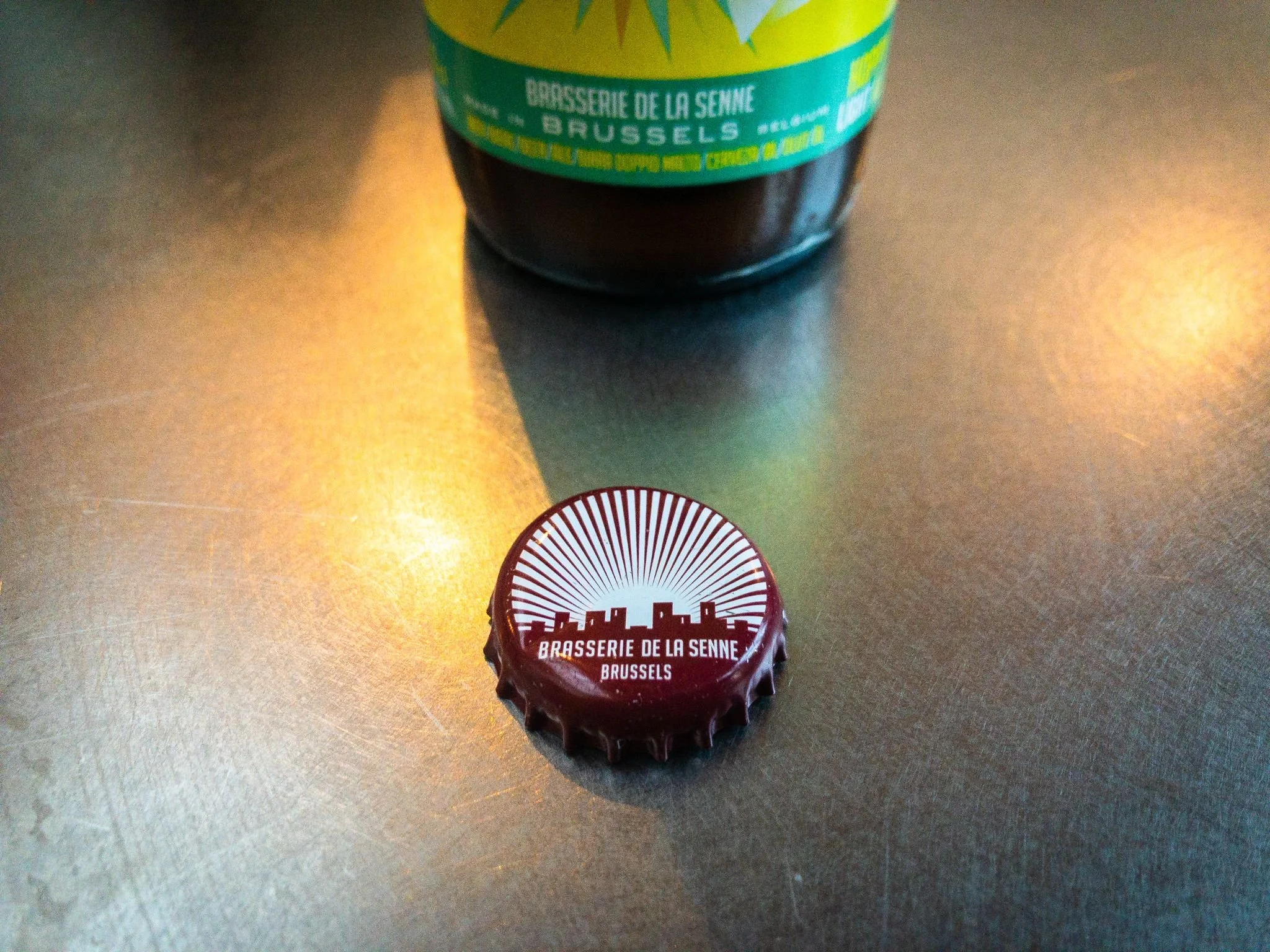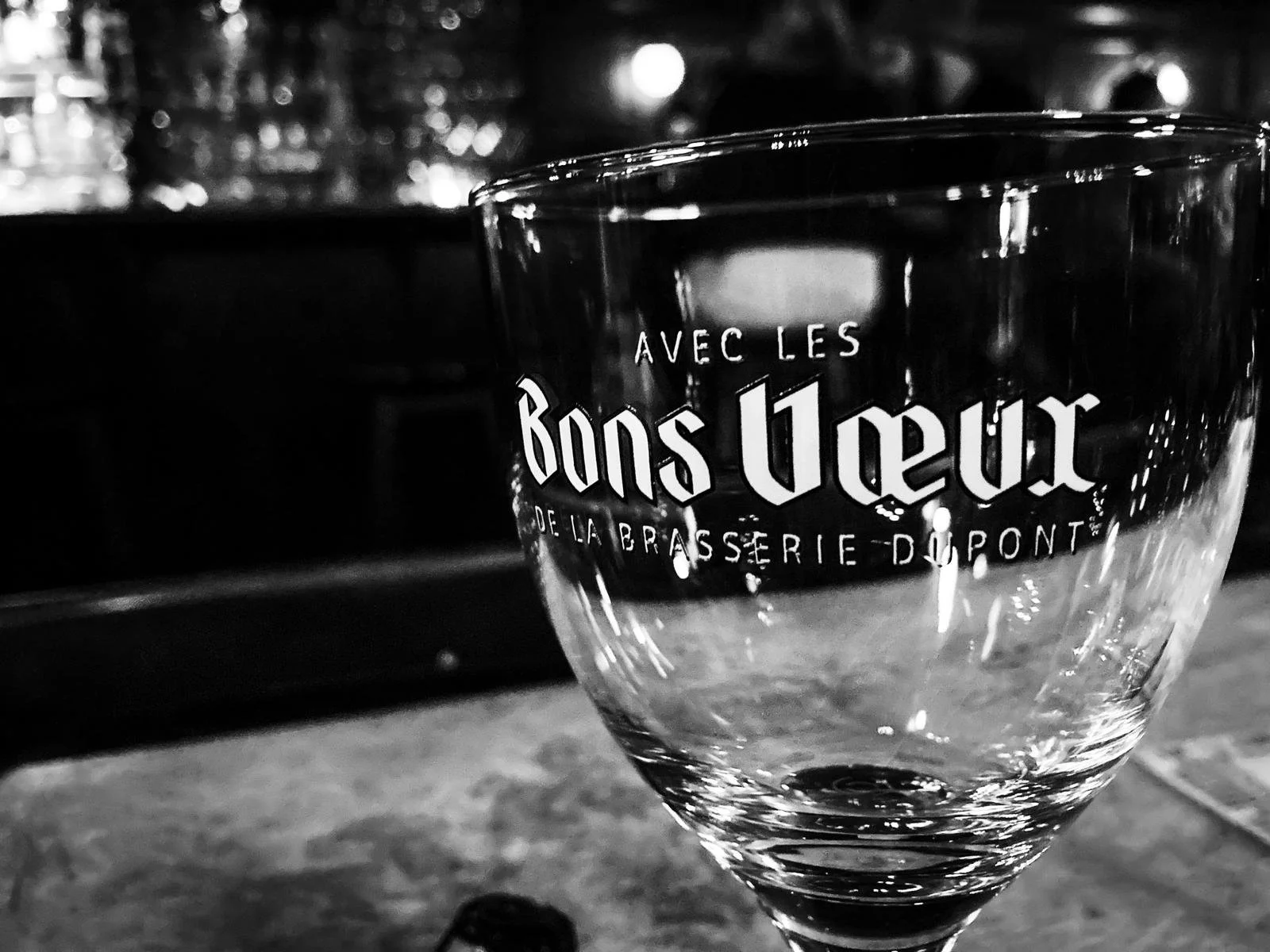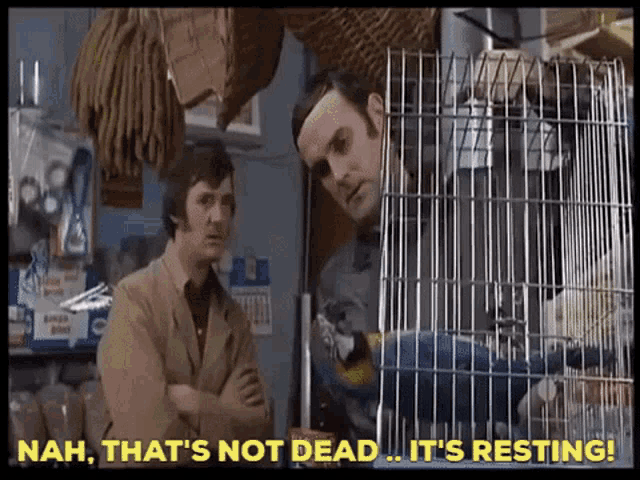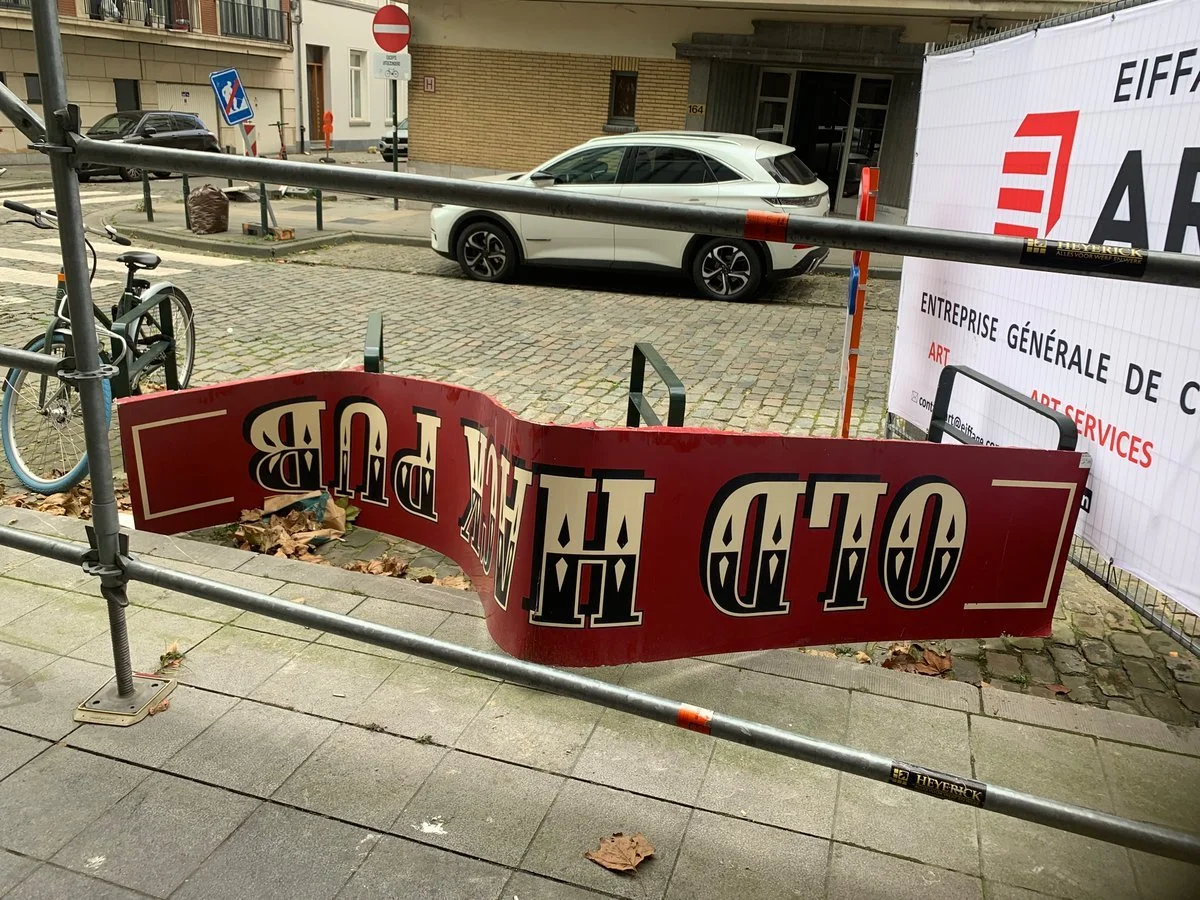Hop Dreams // Brussels gets an urban hop farm
“I’m not a farmer, and I have no knowledge of agronomy. None.” An unorthodox admission from a man in charge of a hop farm. But Christophe Speltiens in an unorthodox hop farmer. How else do you explain his decision to set up an urban hop farm with no agricultural background, and bare bones facilities on the peri-urban margins of Brussels? Kneeling down to tend to the roots of his fledgling hop bines on a muggy summer evening, to hear Speltiens talk about his quixotic endeavour makes it sound almost logical. “There is plenty of water. Normally the soil isn’t polluted. There is no reason why it shouldn’t work.”
(A version of this article originally appeared in Belgian Beer and Food Magazine. Thank you to Paul for letting me republish it.)
Originally planted by monks resident in the area in the 16th century, the Laarbeek forest is an isolated ribbon of green woodland and meadow in the northern Brussels districts of Jette and Ganshoren. It is bordered on one side by the six-lane motorway that loops around Brussels, and on the other by a rail line snaking out towards Flemish commuter towns to the west. Take one of the walking paths leading off the Tentoonstellinglaan in Jette and eventually you come to part gravel, part cobbled track that winds through the wood until it crests a hill on the forest’s western edge.
There, framed against a sullen grey sky pregnant with rain, are soaring wooden poles hammered into the ground at odd angles, holding between them the tangled beginnings of hop bines and hop leafs. On this little patch of grass owned by the municipal government, Speltiens has established Houblons de Bruxelles.
Back from a burnout
It’s a quiet corner of Brussels, save for the occasional clang of a nearby railway crossing as trains whoosh past. But peace and quiet is what Speltiens was looking for. “I worked in IT. I had a burn-out, like lots of IT technicians,” he says. Finding himself out of work, and with a typically Belgian casual interest in beer, Speltiens enrolled in a microbrewing course in Wallonia. When the course finished he planted a couple of hop plants on his terrace while he experimented with developing homebrewing recipes.
“It’s about making a product with terroir… we’re looking for something different, tastes and flavours that we don’t know anymore”
When the local government approached him in 2016 with the idea to plant some vines on an unused plot of land adjacent to a petting zoo, Speltiens initially thought it wouldn’t be much bigger than what he was attempting at home. “I though, 10 plants, 20 plants,” he says. “But then they showed me the size of the field. And I thought, ouh! For starting out, it’s pretty big!” Undeterred, while waiting for a government grant to come through, he set to work. After a successful crowdfunding campaign, and the receipt of the subsidy, an original plot of 10 has since grown to a little under 400 hop plants in the intervening three years.
Testing times
The poles that are visible from the forest were installed in 2018, and he expects the first proper harvest of hop cones in 2020. Everything until then is a test run. “We’re testing to see how we can adapt them to here,” Speltiens says of the German, American, English and Belgian hop varieties he’s planted to date. It is the first time in decades that a new working hop harm has appeared in or around Brussels; the area outside of Brussels around the Flemish towns of Asse and Aalst were once a centre of Belgian hop growing.
With most hop growing now taking place in the fields around Poperinge in West Flanders, only a rump industry remains around the village of Sint-Martens-Bodegem. The area remains a good place to grow hops. “There’s a sort of microclimate out here, less wind and a couple of degrees warmer than in the surrounding area,” he says. “The conditions are really good here.” On this early July evening, most of the hop vines have yet to grow to the top of their five metre-tall guide poles, but it’s clear some varieties have adapted better than others; a couple of vines of the US Chinook hop, tower over their German neighbours – “a little more delicate,” says Speltiens.
In choosing what to plant, Speltiens focused on aroma hops rather than bittering hops: “It’s about making a product with terroir… we’re looking for something different, tastes and flavours that we don’t know anymore.” Space was another natural constraint, as he wanted to get the maximum impact from his 100 metre-long patch of grass to spare for unproductive experiments. Speltiens says ruefully but without complaining that to make it a properly profitable project he would need five hectares and, “in Brussels, that’s not possible.” He will for now squeeze out as much as he can with what he has, while gesturing over a barbed wire fence to an unkempt field next door that he hopes in the future he may be able to annex. There’s a problem though, and one a rusting fence is hopeless at keeping out from his own field: rabbits.
Rabbit proof fence
There’s over a hundred living around the farm, and they are, Speltiens says, “a disaster. They cut the bines…they cut everything.” He points out where, between clumps of rabbit droppings, where and they’ve burrowed underneath rudimentary shields of green plastic netting installed to defend his vulnerable plants, and where they’ve gnawed apart root and stem. Several times as Speltiens patrols between the poles, rabbits emerge from the hedgerows, eyes darting back and forth, damp nose twitching in the muggy evening air. Spotting Speltiens, they slink back into the gloaming.
“It takes time, quoi”
Working in isolated bucolic surroundings has other, more mundane challenges. “We don’t have running water, we don’t have electricity”, he says. “We have nothing.” Once regular harvests start delivering usable hop cones, Speltiens will have to decide whether (and how) to invest in drying equipment to process the hops, though he will not go as far as converting them into pellets. These kinds of investment take money; Speltiens has no interest in becoming wealthy from the hop farm, and even if he wanted to he freely admits his little patch of land wouldn’t allow it. “The investment remains the minimum possible,” he says. “We’re a non-profit for the moment. I would like, at some point in the future, to be able to live off it.”
He has plans to transform Houblons de Bruxelles into a cooperative in the future but for now, he relies on his microbrewing experience for additional income. As part of his initial crowdfunding campaign, Speltiens collaborated with Wallonian brewery Valduc-Thor on a Houblons de Bruxelles beer, called Super Deluxe and based on one of his homebrew recipes. Production has since moved to Brussels and Brasserie En Stoemelings because, Speltiens says, “there was a certain sense in making it with a Brussels brewery. If we’re making a Brussels product, then it makes sense to work with a Brussels brewery.”
“They understand they’re drinking the plants”
As the project develops, there will be the possibility to organise site visits, tours, and cooperative workshops. Speltiens wants people from his hometown to engage with the productive agriculture on their doorsteps, to better understand what goes into the food and drink they are consuming. At the next autumn harvest, “people will be able to come and pick the hops from the vines, hold them in their hands and have a beer,” he says. “And – click – the connection is made. They understand they’re drinking the plants.”
This desire to get people onto his farm, to bring his project to them, may speak to another, less obvious challenge Speltiens has faced: running a hop farm alone in the woods is solitary work. Working in the open air, hands dirty and muscles aching from digging around in the dirt all day, may have been exactly what he needed to move past his burnout, but there’s not much company up here save for the occasional passing jogger or dog walker. In conversation, he refers to the farm as “we”, only to stop himself and clarify that this “we” is in reality just him.
“There was a certain sense in making it with a Brussels brewery. If we’re making a Brussels product, then it makes sense to work with a Brussels brewery”
When he launched Houblons de Bruxelles three years ago, it started very much as a solo run. He didn’t have many connections with the city’s beer community and worked instead to engage people through social media. The stream of volunteers visiting to help install poles or pluck cones have ebbed and flowed over time but Speltiens has gradually integrated himself into the Brussels beer, evidenced by his work with En Stoemelings, and now with Brasserie Cantillon.
Collaborating with Cantillon
One day in September 2018, he found himself one day in Brasserie de la Senne sharing a drink with Cantillon’s Jean Van Roy. Van Roy has long been interested in bringing back some of the now-vanished raw materials that his predecessors would have sourced in Brussels and using to brew lambic in previous centuries. The brewery recently collaborated on a project to bring Schaarbeekse Kriek cherry trees back to Brussels, after the post-war disappearance, for future use in Cantillon’s kriek lambics.
Naturally, the two men ended up discussing Houblons de Bruxelles and what it might take to revive some long-dead hop varieties. “I said, well let’s just plant them here!” says Speltiens. And several months later they did – a couple of rows of low-bitterness Coigneau hop plants, a variety once prized by lambic brewers for its low bitterness levels and grown in abundance in and around the hop fields of Aalst and Asse.
Joining the urban farming movement
Collaborations like these, and projects like Houblons de Bruxelles, are the logical extension of the beer world’s increasing emphasis – from brewers and drinkers alike – on localism. From local breweries in every neighbourhood, we now have breweries making beer with ingredients sourced locally and sustainably, further embedding themselves in the social and economic fabric of the places they are from. This is the motivation behind Cantillon’s work with cherries and hops, and other lambic breweries revival of local and heirloom grains. It’s why Houblons de Bruxelles is not the only urban hop-farming project launched in Europe in the last couple of years.
Beyond beer, Speltiens’ work is part of a broader movement in Brussels that is focused on local, sustainable, and innovative food production taking place within the boundaries of the city. He himself references the honey, vegetable, and goat’s cheese producers who share the Laarbeek forest with him and elsewhere in the city people are building sustainable fish farms on the roof of the city’s abattoir, or growing shiitake mushroom in its cellars, feeding them with Cantillon’s spent grain. In this context, an urban hop farm on the wooded outskirts of Brussels, is less a quixotic adventure and more another piece of the urban farming puzzle.
You’ve got time
Speltiens is too preoccupied with his work to give these broader trends much attention. Above the hop field, sodden clouds unburden themselves on the field as the grey evening sky mottles and darkens. Speltiens is satisfied with his work, and for him the chance to toil up here above the city is also a chance to spend time where time and its pressures melt away. Time is something he has in abundance.
You don’t build a hop farm in 24 months. It will be another couple of years before a Super Deluxe brewed with homegrown Chinook hops will appear. As for a Cantillon gueuze blend made with Houblons de Bruxelles Coigneau? Another seven years, if not longer. While he waits for all this, Speltiens has plants to attend to. “There’s not a lot right now. It’s starting to become possible to show people what’s going on, but there’s not much yet. It takes time, quoi.”
He returns to his ministrations, crouching low to the ground to assess the latest damage inflicted by the rodents on the other side of the fence. He looks up absentmindedly from his work, and there, standing quietly amongst the hop bines, is a fox joining him on the hunt for rabbits. They eyeball each other for a moment, whiskers bristling and breath held, until the fox recedes back into the woodland.
A version of this article originally appeared in Belgian Beer and Food Magazine. Thank you to Paul for letting me republish it here.













